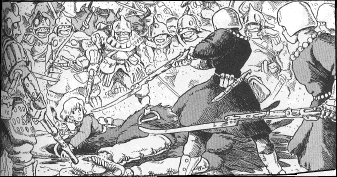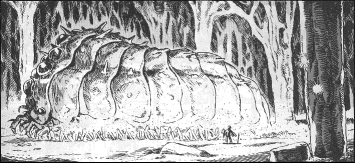

| June 1998 |
|
| Hayao Miyazaki: Nausicaä of the Valley of Wind | |
Still, this is the longest single story I've ever read in comics. Dave Sim's Church & State exceeded its 1063 pages, but Miyazaki has easily twice the panels per page as Sim, so Nausicaä is really the longer work. (Ranma 1/2 runs to 6840 pages, but it's episodic in form-- no more a single work than the collected Star Trek is a science fiction novel.)
 What is it? In a sense it's your standard post-acopalypse revenge-of-nature Japanese science fiction story. Industrial culture has destroyed itself and rendered most of the planet into a 'Sea of Corruption', where only enormous insects and fungi can survive the poisonous miasma. Undaunted by this example of folly, the straggling present-day empires embark on a great war. Nausicaä, princess of a tiny kingdom on the periphery of the Torumekian empire, is drawn into the war, though her real calling is to understand the workings of the new ecosystem of the Sea of Corruption.
What is it? In a sense it's your standard post-acopalypse revenge-of-nature Japanese science fiction story. Industrial culture has destroyed itself and rendered most of the planet into a 'Sea of Corruption', where only enormous insects and fungi can survive the poisonous miasma. Undaunted by this example of folly, the straggling present-day empires embark on a great war. Nausicaä, princess of a tiny kingdom on the periphery of the Torumekian empire, is drawn into the war, though her real calling is to understand the workings of the new ecosystem of the Sea of Corruption.
An accompanying note by the author notes that Nausicaä is an amalgam of the mythological princess of the same name, who succored Odysseus when he washed up on her shore, and a Japanese princess of the Heian period, who was not only fascinated with insects even as an adult, but scorned the conventions of beauty of those times: shaving the eyebrows and blackening the teeth.
I'd call it the War and Peace of comics, if I didn't suspect that no one reads Tolstoy any more. It's an odd but very human mixture, full of scenes of violence and horror, yet informed throughout with the princess's compassion-- not that she's exactly a pacifist; she has a fiery temper, and her irony is that as she finds her way of peace, she is responsible for more than her fair share of deaths. And for all the author's obvious sympathy with Nausicaä, he depicts the battle scenes, and the fighters, such as the warrior princess Kushana and Nausicaä's mentor, old Master Yupa, with gusto.
The last pages of the book are indeed a sort of debate on the violence and joy of the human spirit. Could violence and suffering be removed from the world? If they were, could human beings be suffered to live in it? And would you trust the guardians of that world?
These are not new themes, but they are refreshed here by Miyazaki's breadth of moral vision. Unlike Tolkien, George Lucas, and virtually every other fantasy-monger, he does not go in for a simple tale of good vs. evil. There is no character, no matter what evils they do, who emerges as simply Eeevil; and even the monsters (such as the near-brainless fighting machines, the Heedra; or the superhuman, roilingly organic God-Warrior) are viewed with compassion.
 There's a little of everything here: the machinations of two corrupt imperial courts; a glorious, forty-page battle; dreams and spiritual battles; scenes of horror and scenes of elevating beauty.
There's a little of everything here: the machinations of two corrupt imperial courts; a glorious, forty-page battle; dreams and spiritual battles; scenes of horror and scenes of elevating beauty.
The drawing is not the usual slick, hard-edged manga style, but sketchy and evocative, reminiscent of Moebius. I'm told, in fact, that Miyazaki is one of the few manga creators who eschews the help of a studio, and insists on drawing everything himself.
If I have any complaint, it's that Miyazaki, for all his love of the natural world (as for instance his creation of the awesome, dinosaur-sized Ohmu), doesn't seem to have learned much biology. Doesn't he know that insects have only six legs, and that their mouths open horizontally, not vertically?
| Carol Lay: Joy Ride | |
Joy Ride collects nearly a year's worth of these, which you can eat up like popcorn. But the real meat is the 60-page title story, the story of an immensely fat woman and the retired pop star who's hired to drive her mind in order to lose weight. (And let's not forget the evil lovers, the infallible Madame Asgar (also a regular in Story Minute, and the fat fetishists of the Zone.)
Light and readable, it also makes a great sf story. (Better than the French sf strips, in fact... the French forget that dazzling art isn't enough; there also has to be a human connection.)
Lay has a stylized, cartoony way of drawing, which suits both stories fine. And her use of blacks is expert; like Walt Holcombe, she comes as close as possible to making black & white look like it was printed in vibrant color.
